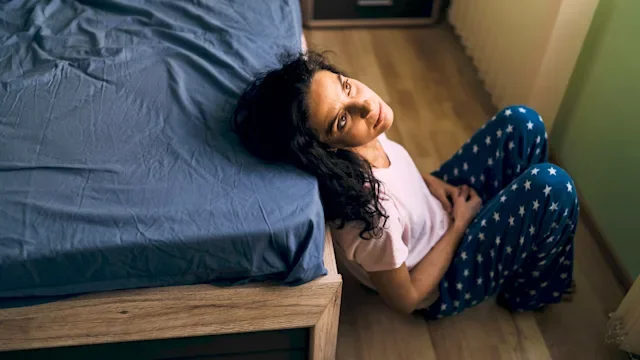Key takeaways:
Hot flashes are a common part of menopause, but they can be quite uncomfortable and disruptive to daily life. Fortunately, there are treatment options that can offer hot-flash relief.
Natural remedies for hot flashes include dietary and lifestyle strategies, and supplements. These treatments can lower how often, how long, and how strong you get your hot flashes.
Hot flashes can sometimes last a long time. They can continue for months to years after menopause.
Hot flashes are sudden bursts of internal heat and can include sweating on the face, neck, or chest. These flashes of heat are unpleasant, uncomfortable, and unpredictable. You might be one of the more than 80% of people feeling the heat of menopause. The midlife transition to menopause (when your monthly periods stop) often comes with hot flashes.
While there’s no cure for hot flashes, there are lifestyle strategies and nonhormonal therapies that may help you turn the heat back down. If you’re looking for natural remedies for hot flashes, there are a few options that have been shown to help. Let’s take a closer look at these alternative treatments and how you can stop hot flashes.
1. Exercise
Regular exercise, 3 or more times a week, may help ease your discomfort with hot flashes. Physical activity could lessen the length, severity, and number of hot flashes you have. People who stick to an exercise regimen self-report a better time handling hot flashes.
Exercise can also have a positive effect on other issues you may face with menopause. It may help to improve your:
Quality of sleep
Mood
Energy
Weight
Stress
Physical activity may also improve your outlook and reaction to hot flashes. This may make it a little easier to cope with them.
There’s some data that exercise might actually trigger hot flashes in some people by raising your body temperature. If you notice an increase in hot flashes with exercise, try a low-intensity exercise like walking.
2. Eat more fruits and veggies
Eating more water-rich foods, such as fruits and vegetables, may help limit hot flashes. Tweaking your diet can help cool the body down and keep you hydrated. A few staples with high water content to keep on hand are:
Lettuce
Cucumbers
Berries
Watermelon
Bananas
Avocados
Celery
Broccoli
Carrots
What does a hot flash feel like? Three women share their experience with hot flashes and how they managed them.
Did you know hot flashes can start before menopause? Learn more about the symptoms of perimenopause and what you can expect in your 40s.
Supplements for menopause symptoms: Find out which supplements can help you navigate menopause and which ones to avoid.
3. Try a Mediterranean or plant-based diet
A Mediterranean diet can also tame hot flashes. Although it’s not entirely clear why, people who eat this kind of a diet seemed to have fewer hot flashes. The Mediterranean diet typically includes:
Fruits
Vegetables
Grains
Potatoes
Beans
Nuts
Dairy
Eggs
Small amounts of fish and poultry
A plant-based diet along with whole soybeans may also help to control hot flashes. Soybeans contain isoflavones. In some people, these are broken down to equol (an estrogen-like substance) by bacteria in the gut. This is especially the case when eaten as a part of a vegetarian or vegan diet. For some, equol could lead to fewer hot flashes.
Read more like this
Explore these related articles, suggested for readers like you.
4. Limit spicy and sugary foods
You may need to cut back on hot or spicy and sugary foods to curb hot flashes. Adding a kick to your meal with chili powder, peppers, and other spices can cause blood vessels to widen. This could then lead to sweating and flushing.
Also, spikes in blood sugar raise the likelihood of hot flashes. According to research, if you’re in the early years of menopause or if you’re African American, having a higher blood sugar may be more likely to cause vasomotor symptoms.
5. Choose water instead of other beverages
Your choice of beverage may make a difference if you have hot flashes. It might be a good idea to limit your intake of caffeinated and alcoholic drinks. They can trigger or worsen hot flashes in some people.
The data is mixed for alcohol, though. Some studies show that it may help, while others show that alcohol can worsen hot flashes. This may be because alcohol dilates (widens) the blood vessels, as spicy foods do, so it could bring on the heat. Either way, the consensus among healthcare professionals is to keep your drinking at a light to moderate level. You can do this by limiting yourself to 1 drink or less a day. If your hot flashes are hard to manage, it might be a good idea to cut down on the alcohol.
That said, it may be a better choice to quench your thirst with water. Replacing water loss from hot flashes can help to maintain a lower body temperature. Being dehydrated can raise your temperature, but sipping water can help prevent that.
6. If you smoke, stop smoking
If you smoke, it’s always a good time to kick the habit and stop smoking. If you haven’t been able to do so, transitioning to menopause may give you an incentive. It’s unclear why hot flashes are worse if you smoke. But smoking might lower your estrogen levels, which may raise your chances of hot flashes.
If you’re struggling with hot flashes and you smoke, try setting a quit date. Among the many benefits of quitting, it may just help you cool off and help your hot flashes, too.
7. Try to keep cool
Hot flashes can be triggered by changes to your body’s core temperature. Keeping your body temperature steady and cool can help hot flashes. Try to be proactive about staying cool, including what you wear. Style your wardrobe to keep cool. Dress in loose-fitting layers, so when the heat is on, you can shed layers.
You may want to choose fabrics that breathe, such as linen, rayon, and cotton. Wearing moisture-wicking clothes may also help you stay drier. The same thing is true at night. Cooling pajamas, sheets, and a mattress can help lull you into a restful night sleep.
You can also turn the thermostat down. You may find your comfort zone to be between 60°F and 72°F (about 16°C and 22°C). But you can move it up or down as needed.
8. Stay calm and reduce stress
Anxiety can set the body’s fight-or-flight response in motion, leading to a rise in body temperature. This can trigger a wave of intense heat that feels like a hot flash. Anxiety and stress levels have also been linked to a greater severity and number of hot flashes.
The good news is you can lower the effect of stress on your body. A few ways you can manage anxiety and stress include:
Progressive muscle relaxation, tensing and relaxing each muscle group one at a time
Focused, intentional breathing
Journaling or doodling
9. Consider supplements
Taking herbal supplements may take the edge off of uncomfortable hot flashes and give you some relief. Plants, roots, and herbs have compounds called phytoestrogens. They mimic the effects of estrogen and lower the risk of flushing and sweating.
But some supplements for hot flashes don’t mix well with prescription medications and may even be harmful. Speak with a healthcare professional about these before giving them a try:
Valerian root (Valeriana officinalis)
Fenugreek (Trigonella foenum)
Maca (Lepidium peruvianum)
10. Meditate
Hot flashes can get worse when you’re stressed or when your body’s nervous system is out of sync. Meditation is the practice of slowing down and shifting your focus to become aware of your present surroundings. Mindfulness-based stress reduction, like meditation, can help by:
Calming your body
Improving your sleep and mood
Reversing chronic stress
Over time, meditation can help to reduce how often hot flashes happen and their intensity.
11. Try acupuncture
Traditional Chinese medicine sees hot flashes as a sign of “yin deficiency” or too much internal heat. Some people use acupuncture to help cool the body and bring it back in harmony.
Acupuncture experts believe it may help to control body temperature by:
Improving the body’s energy flow
Balancing hormones like estrogen
Supporting brain chemicals, such as serotonin and endorphins
However, research results are mixed on whether acupuncture really works for hot flashes.
What causes hot flashes?
The exact reason hot flashes occur isn’t fully understood. But it may be due to a shift in hormones and a dysfunction in the body’s temperature control system. During menopause there are many hormonal changes. These changes include:
A drop in estrogen levels
A raise in norepinephrine levels
An overexpression of serotonin receptors
This chain of events may lead to a sensitivity to changes in body temperature. And this may trigger menopausal hot flashes.
How long will hot flashes last?
It’s unclear how long hot flashes last. Hot flashes usually don’t end once menopause actually starts — they can go on for many years beyond that. The average length of menopause symptoms is 7 years, but it can go on for over 10 years.
Everyone is different. If hot flashes greatly affect your quality of life, you should speak with a healthcare professional. In severe cases, a combination of natural remedies and menopause hormone therapy (also known as hormone replacement therapy) could be an option.
Frequently asked questions
Vitamin B12 doesn’t directly stop hot flashes. But it can support overall health in ways that can indirectly manage them — especially if your vitamin B12 level is low. B12 deficiency can lead to fatigue, mood changes, poor sleep, and nerve issues. This can worsen how you experience hot flashes. If you’re having these symptoms, talk with a healthcare professional about checking your vitamin B12 level.
When it comes to hot flashes, there are a few drinks that can help take the edge off. These drinks provide hydration, and can replenish nutrients and minerals, which may help reduce hot flashes over time. Drinks you may want to consider include:
Some studies suggest that folic acid may help reduce how often and how severe hot flashes are in women who aren’t using hormone therapy. Folic acid plays a key role in making serotonin and dopamine — brain chemicals that help the body control your temperature and mood.
Vitamin B12 doesn’t directly stop hot flashes. But it can support overall health in ways that can indirectly manage them — especially if your vitamin B12 level is low. B12 deficiency can lead to fatigue, mood changes, poor sleep, and nerve issues. This can worsen how you experience hot flashes. If you’re having these symptoms, talk with a healthcare professional about checking your vitamin B12 level.
When it comes to hot flashes, there are a few drinks that can help take the edge off. These drinks provide hydration, and can replenish nutrients and minerals, which may help reduce hot flashes over time. Drinks you may want to consider include:
Some studies suggest that folic acid may help reduce how often and how severe hot flashes are in women who aren’t using hormone therapy. Folic acid plays a key role in making serotonin and dopamine — brain chemicals that help the body control your temperature and mood.
The bottom line
There’s no one guaranteed way to treat hot flashes. But a combination of natural remedies can give you hot-flash relief. Dietary strategies, supplements, and day-to-day changes can help your hot flashes. It will likely require trial and error to find out the best treatment.
But remember, natural remedies can have side effects, too. So make sure you talk with a healthcare professional for guidance on where to start.

Why trust our experts?


References
American College of Obstetricians and Gynecologists. (2025). What can I do to help with hot flashes?
Bailey, T. G., et al. (2016). Exercise training reduces the frequency of menopausal hot flushes by improving thermoregulatory control. Menopause.
Bani, S., et al. (2013). The effect of folic acid on menopausal hot flashes: A randomized clinical trial. Journal of Caring Sciences.
Bansal, R., et al. (2019). Menopausal hot flashes: A concise review. Journal of Mid-Life Health.
Barnard, N. D., et al. (2021). The women's study for the alleviation of vasomotor symptoms (WAVS): A randomized, controlled trial of a plant-based diet and whole soybeans for postmenopausal women. Menopause.
Berin, E., et al. (2019). Resistance training for hot flushes in postmenopausal women: A randomised controlled trial. Maturitas.
Carmody, J., et al. (2011). Mindfulness training for coping with hot flashes: Results of a randomized trial. Menopause.
Centers for Disease Control and Prevention. (2024). About water and healthier drinks.
Centers for Disease Control and Prevention. (2024). How to quit smoking.
Ee, C., et al. (2017). Acupuncture for menopausal hot flashes: Clinical evidence update and its relevance to decision making. Menopause.
Faubion, S. S., et al. (2015). Caffeine and menopausal symptoms: What is the association? Menopause.
Foley, L., et al. (2025). Bedroom environment: What elements are important? Sleep Foundation.
Freeman, E. W., et al. (2005). The role of anxiety and hormonal changes in menopausal hot flashes. Menopause.
Freeman, E. W., et al. (2016). Anxiety as a risk factor for menopausal hot flashes: Evidence from the Penn Ovarian Aging Cohort. Menopause.
Gallicchio, L., et al. (2015). Risk factors for hot flashes among women undergoing the menopausal transition: Baseline results from the Midlife Women's Health Study. Menopause.
Herber-Gast, G. M., et al. (2013). Fruit, Mediterranean-style, and high-fat and -sugar diets are associated with the risk of night sweats and hot flushes in midlife: Results from a prospective cohort study. American Journal of Clinical Nutrition.
Kargozar, R., et al. (2017). A review of effective herbal medicines in controlling menopausal symptoms. Electronic Physician.
Kwon, R., et al. (2022). Alcohol consumption patterns and risk of early-onset vasomotor symptoms in premenopausal women. Nutrients.
Mahajan, A., et al. (2018). Hot flashes—How long ?? Journal of Mid-Life Health.
Meissner, H. O., et al. (2005). Use of gelatinized maca (Lepidium peruvianum) in early postmenopausal women. International Journal of Biomedical Science.
Mirabi, P., et al. (2013). The effects of valerian root on hot flashes in menopausal women. Iranian Journal of Pharmaceutical Research.
Morrow, P. K. H., et al. (2011). Hot flashes: A review of pathophysiology and treatment modalities. The Oncologist.
National Institute on Aging. (2021). Hot flashes: What can I do? National Institutes for Health.
Office of Dietary Supplements. (2020). Black cohosh: Fact sheet for health professionals. National Institutes of Health.
Polasek, D., et al. (2024). Nutritional interventions in treating menopause-related sleep disturbances: A systematic review. Nutrition Reviews.
Safabakhsh, M., et al. (2020). Higher intakes of fruits and vegetables are related to fewer menopausal symptoms: A cross-sectional study. Menopause.
Schilling, C., et al. (2007). Current alcohol use, hormone levels, and hot flashes in midlife women. Fertility and Sterility.
ScienceDirect. (n.d.). Coconut water.
Setchell, K. D. R., et al. (2010). Equol: History, chemistry, and formation. The Journal of Nutrition.
Smith, R. L., et al. (2015). Does quitting smoking decrease the risk of midlife hot flashes? A longitudinal analysis. Maturitas.
Steels, E., et al. (2017). Efficacy of a proprietary Trigonella foenum-graecum L. de-husked seed extract in reducing menopausal symptoms in otherwise healthy women: A double-blind, randomized, placebo-controlled study. Phytotherapy Research.
The Menopause Society. (2024). Too much exercise could actually trigger a hot flash.
Thurston, R. C., et al. (2012). Vasomotor symptoms and insulin resistance in the study of women's health across the nation. Journal of Clinical Endocrinology and Metabolism.















